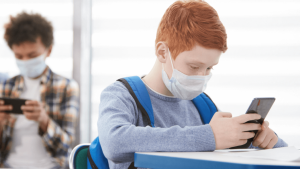
Parents, teachers, clinicians, and others must help children and teens readjust to “normal” life. “Although so many facets of our lives have been disrupted, and screens have certainly been a lifeline for many of us, it’s time to help families start a conversation about how kids can approach resetting their activities, habits and routines, and reducing their reliance on digital media” says Dr. Pamela Hurst-Della Pietra, founder and president of Children and Screens. With that in mind, a distinguished panel of researchers, clinicians, educators, and parenting experts have teamed up to share their tips for navigating the ongoing pandemic.
1. Listen up and Validate
Many areas of a child’s socio-emotional life, learning, behaviors and habits have been disrupted during the pandemic, so it’s important for parents to open up space for children to share and explore their feelings. Parents should listen to children’s concerns and take them seriously rather than pretend that these troubling feelings don’t or shouldn’t exist. “Ask your child to explain what worries them before you attempt to reassure them,” says David J. Schonfeld, MD, FAAP, Director of the National Center for School Crisis and Bereavement at Children’s Hospital Los Angeles. “Correct any misunderstandings or misinformation that children may have that contributes to their worries, but don’t minimize the concerns they share. Adults should also share some of their own concerns with their kids, with an emphasis on modeling healthy strategies for dealing with those feelings.”
Grief can take many forms beyond the passing of a loved one. This year has seen children lose out on sports seasons, extracurricular activities, milestones, celebrations, and social connections, and it’s important for parents to acknowledge the emotions that come with different kinds of loss. “Kids may express grief in different ways, on different timelines, and about different things, and we have to allow space for that without trying to fix it too quickly,” says Amanda Zelechoski, PhD, Associate Professor of Psychology at Valparaiso University and co-founder of Pandemic Parenting. “However, in addition to acknowledging the grief, we need to balance that with noticing and acknowledging moments of joy and gratitude as they come up, and to remind our kids (and ourselves) that this won’t last forever.” Dr. Zelechoski reminds us all that “there may be things we learn along the way that build our individual and collective strength and resilience.”
2. Be Their Confidence Booster, One Step at a Time
The majority of students will greet the return to school with relief and joy, but it’s important to remember that a small but significant number of young people with anxiety symptoms will struggle with the return to in-person learning. “The comfort of staying at home with parents close by, as well as the ability to avoid traditional social demands by hiding behind a screen, will come to an abrupt end for many children when schools open,” says Harold S. Koplewicz, MD, President of Child Mind Institute. He recommends speaking with children’s teachers and asking them to call on them virtually.
In addition, many children may be feeling worried about returning to ‘normal’ social interactions and may have been feeling lonely. “Kids may need extra support to gradually build their confidence, step-by-step,” explains Maria Loades, PsyD, a Clinical Psychologist. Loades notes that it may be helpful for some children to write their thoughts in a diary, and recommends encouraging children “to reframe their mindset to think more positively and help them to recognize the social connections they do have.”
3. Model Good Communication, From Behind the Mask
While our eyes are very expressive, it can still be difficult to read social cues and the nuances of emotion when everyone’s wearing a mask, especially for kids. “Work on being precise and descriptive in speaking with your child, and help them learn to do the same,” says Heather Lewis, MA, Consultant/Curriculum Writer at University of Michigan’s InPACTatHome Program. “Remind them that others may not be able to read their feelings or intentions from behind a mask, and highlight the importance of using their words to effectively communicate how they’re feeling.” She highlights that younger children will need even more help with this.
4. Keep What Worked
While the pandemic has resulted in major shifts in our lifestyles, these changes have not all been negative. Patricia Greenfield, PhD, Distinguished Professor of Psychology at UCLA, invites families to “take stock of how your family has connected during this time at home, and keep creating those moments of connection.” Dr. Greenfield notes that “families are speaking more to each other, cooking together more often, and sitting down for family meals in a way pre-pandemic busy schedules didn’t allow.” She invites parents and caregivers to be intentional about continuing family dinners and parent-child check-in times as frequently as possible, rather than jumping back into schedules that were too crowded for these important bonding activities.
5. Remind Them to Stay the Course, It’s Not Over Yet
Just like adults, kids are going to have concerns about going back to in-person school while the virus continues to circulate. Kids do better when they’re appropriately informed, though of course we don’t want to scare or overwhelm them with too much information. “Even as we tell children that we’re encouraged by the number of people getting vaccinated, not enough people (either in the U.S. or around the world) are getting vaccinated to completely stop the spread of the virus,” says Dave Anderson, PhD, Vice President of School and Community Programs at the Child Mind Institute. “It’s important to remind kids that we all need to do our part to keep ourselves and those around us healthy by continuing to engage in the same health practices that ensure we’re not spreading the virus to those who could still get sick.” It’s important to remind your children that even though we feel safer, we still need to wear masks, wash our hands frequently, and keep a safe distance. It’s imperative that parents model this behavior, too.
6. Take Your Time
The pandemic has taken a heavy toll on many, costing lives, jobs, hope, and the ability to express love and support in physical, face-to-face ways. “Reintegrating into a world where people turn towards each other may be tough, especially when our directions for so long have been to shelter, keep our distance, and turn away,” says Michelle Drouin, PhD, Professor of Psychology at Purdue University Fort Wayne. “We’ll all have to re familiarize ourselves with the shape of intimacy and how it factors into our closest relationships.” Not everyone will be ready to integrate to physical, face-to-face interactions right away, and Dr. Drouin reminds us that it’s important to show patience and understanding, and for parents to model healthy social interactions for their children whenever possible.
7. Forward Positive Thinking
Rather than focusing on “going back” and how to adjust to how school and life was like prior to the COVID-19 pandemic, Alexis Lauricella, Ph.D., M.P.P. encourages parents and educators to think positively about how we move into a new version of education. “What are the new and exciting things that have come out of this experience? Our students learned to be more patient, more flexible, resilient, and more independent,” she explains. “How can we encourage our students to keep building on some of those skills when they go to school? How can educators continue to build and support those critical skills in the school environment? What did we like from this past year and how can we continue to incorporate it into our learning and development?” This is an opportunity to think creatively and positively about the silver linings that have come out of this pandemic rather than focusing on going back to what was not an ideal education system to start with.
8. Show Them the Future
When discussing the return to life after lockdowns, it’s important to tailor your approach to the age and developmental level of the child. “For example, with younger children, stick to concrete and simple explanations over abstract language and overexplaining,” says Debra Reicher, PhD, Clinical Assistant Professor at Stony Brook University’s Department of Psychiatry. “Establishing a new and predictable routine can also help mitigate anxiety.” Reicher suggests that teachers and parents provide pictures or video tours of what school will look like going forward, share details about new protocols like and washing and temperature checks, and set realistic expectations about PE, lunch, and more.
9. Intentional Summertime
Summer is a necessary time for kids to reset their brains, take a break from hours sitting doing work at desks on screens, and have the freedom to follow their curiosity and play for hours on end. “If you can’t visit your cousins, you can still play charades on zoom,” suggests Dr. Catherine Steiner-Adair, Clinical Psychologist and author of The Big Disconnect: Protecting Childhood and Family Relationships in the Digital Age. “If your children are required to be inside, check out the amazing online camps. No matter where you live, you can hang a hammock, gaze at the stars, read the stories of constellations and sleep in a tent! Bring down screen related tensions by creating a family plan about what where when and why screens will be engaged. Most of all, remember summer is an ideal time to create tech free days, weekends, vacations – whatever your work and circumstances allow.”
10. Wean the Screens
Screen time has seen a major spike during the pandemic for kids of all ages, who have come to rely on their devices for education, socialization, and entertainment. Adjusting back to life in the real world won’t be easy, and needs to be approached gradually, says Larry D. Rosen, PhD, Professor Emeritus at California State University, Dominguez Hills. “Kids will beg you to let them play Fortnite or use social media, claiming that their ‘friends’ are expecting them,” explains Rosen. “Don’t cut them off cold turkey. Instead, keep track of their screen use for a week prior to the change and wean them off slowly.” Martine Oglethorpe of The Modern Parent agrees, suggesting that parents discuss the role that screens have played over the last year with their kids and brainstorm about how they might find the experiences they get on screen in off-screen environments, like they did before the pandemic. “What are the habits and rituals that you want to keep, and what are those that you may need to let go of?” asks Oglethorpe. “Talk to your kids about the things that screens couldn’t replace during lockdown, and help them work towards being grateful for those experiences as they return.”
As you begin to set new limits on screen time, be prepared for your child to complain about being “bored,” but remember that boredom can be highly beneficial for kids. “They’ll resist that feeling of nothingness at first,” says John Hyatt, director of the critically acclaimed documentary ‘Screened Out,’ “but they’ll learn to explore and find something to do. Kids and teens will always fight for what they want, finessing their negotiation skills, but stay firm. The kids will be alright.”



